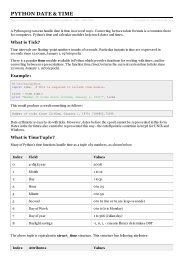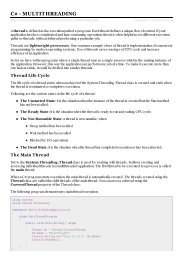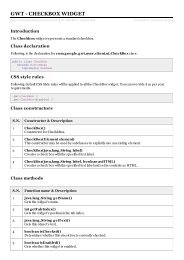Tutorials Point, Simply Easy Learning
Tutorials Point, Simply Easy Learning
Tutorials Point, Simply Easy Learning
Create successful ePaper yourself
Turn your PDF publications into a flip-book with our unique Google optimized e-Paper software.
18 | P a g e<br />
<strong>Tutorials</strong> <strong>Point</strong>, <strong>Simply</strong> <strong>Easy</strong> <strong>Learning</strong><br />
UML Standard Diagrams<br />
In the previous chapters we have discussed about the building blocks and other necessary<br />
elements of UML. Now we need to understand where to use those elements.<br />
The elements are like components which can be associated in different ways to make a<br />
complete UML pictures which is known as diagram. So it is very important to understand the<br />
different diagrams to implement the knowledge in real life systems.<br />
Any complex system is best understood by making some kind of diagrams or pictures. These<br />
diagrams have a better impact on our understanding. So if we look around then we will realize<br />
that the diagrams are not a new concept but it is used widely in different form in different<br />
industries.<br />
We prepare UML diagrams to understand a system in better and simple way. A single diagram is<br />
not enough to cover all aspects of the system. So UML defines various kinds of diagrams to<br />
cover most of the aspects of a system.<br />
You can also create your own set of diagrams to meet your requirements. Diagrams are<br />
generally made in an incremental and iterative way.<br />
There are two broad caetgories of diagrams and then are again divided into sub-categories:<br />
� Structural Diagrams<br />
� Behavioral Diagrams<br />
Structural Diagrams:<br />
The structural diagrams represent the static aspect of the system. These static aspects<br />
represent those parts of a diagram which forms the main structure and therefore stable.<br />
These static parts are represents by classes, interfaces, objects, components and nodes. The<br />
four structural diagrams are:<br />
� Class diagram<br />
� Object diagram<br />
� Component diagram<br />
� Deployment diagram<br />
Class Diagram:<br />
Class diagrams are the most common diagrams used in UML. Class diagram consists of classes,<br />
interfaces, associations and collaboration.<br />
Class diagrams basically represent the object oriented view of a system which is static in nature.<br />
Active class is used in a class diagram to represent the concurrency of the system.<br />
Class diagram represents the object orientation of a system. So it is generally used for<br />
development purpose. This is the most widely used diagram at the time of system construction.<br />
Object Diagram:<br />
Object diagrams can be described as an instance of class diagram. So these diagrams are more<br />
close to real life scenarios where we implement a system.

















